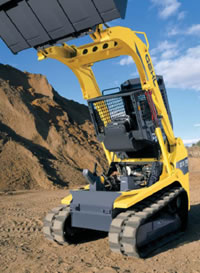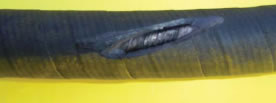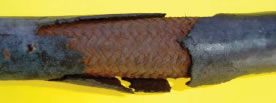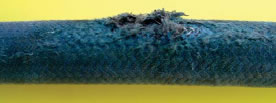Cleaning the Pipes
 The life of a loader’s hydraulic hose is a grueling existence. Hydraulic hoses are the veins for your compact machine’s hydraulic system, powering everything from its loader arms to its attachments. Like our own circulatory system they work in a harsh and unseen environment, often left neglected.
The life of a loader’s hydraulic hose is a grueling existence. Hydraulic hoses are the veins for your compact machine’s hydraulic system, powering everything from its loader arms to its attachments. Like our own circulatory system they work in a harsh and unseen environment, often left neglected.
Even more so on compact equipment that are designed to work in cramped quarters where space is an issue, which often means that the hydraulic systems on a machine like a skid steer are smaller with littler component parts fitted into an even tinier serviceable areas.
Just like regularly checking the lubricant level or the grease points on your skid steer, mechanics and operators need to occasionally eyeball the unit’s hydraulic hose system as well, inspecting for abrasion, wear, tear and site damage.
Hydraulic hose failure on any piece of equipment can bring it to a standstill in seconds and can take a long time to repair. A quick visual inspection of the high-pressure hoses on your equipment before it is dispatched to a jobsite or before it gets rented out can save a lot of headaches and downtime.
If a skid steer is sent to a jobsite in a neighboring town or city, more than an hour’s drive from your facility, and oil starts leaking profusely, most companies will send a service technician on site to see if they can carry out a repair. When available, the technician can spend an hour to get to the site to access the reason for oil coming out from under the machine. They spend an average of 30 minutes to an hour removing the hose assembly, depending on the location and the accessibility of the broken hose.
The technician then has to find and locate a hose shop or main dealer to find a replacement part. If they are not familiar with the local area, it may mean that they have to drive back close to where they started from to get a new one made and then drive back to site and re-fit it to the machine.
To reduce the downtime on site of your fleet of skid steers, compact machines and other equipment, you can take some basic steps before the equipment leaves your facility. First off, carry out a visual inspection of the exposed hoses on your equipment and get the damaged or worn ones replaced before they leave your facility. If you can easily see these hoses they are the ones that are most likely to be damaged externally and are the ones most susceptible to wear.
Identifying Hose Failures
There are six common hose failure scenarios. Once identified, the solutions for repair are straightforward.
1. Abrasion: The hose has failed with clear signs of rubbing on the outer cover.
Solution: Check to see if the hose can be re-routed. Use clamps to hold the hose or use a hose guard on the replacement hose as additional protection.
2. Excessive Heat: The hose cover and/or the inner tube are brittle to the touch and have a cracked appearance. The hose is not flexible at room temperature.
Solution: Choose a hose that has the correct temperature rating for the application and provide additional protection with heat shields or fire jackets.
3. Excessive Pressure: The hose has burst cleanly with no random wire breakage or cover abrasion.
Solution: Verify the system operating pressure and correct setting. Choose a hose that meets or exceeds the pressure rating for the application.
4. End-Fitting Blown Off: The end-fitting has blown off the hose either with or without the ferrule, with no other external damage evident.
Solution: Ensure the correct assembly procedures have been followed. Refer to your product’s catalogue for guidelines. Ensure that only the correct parts have been used and never mix components from different manufacturers.
5. End-Fitting Broken Off: The fitting has broken off leaving some or all of the fitting tail inside the inner tune and the ferrule still attached.
Solution: The fitting has broken off due to outside influence. Try to identify the source of this outside damage and eliminate by re-routing the hose or correctly routing the hose in the case of a poor previous repair. Always re-use any brackets that are provided by the manufacturer.
6. Incompatible Fluid: The inner tube is deteriorated, swollen and the outer cover may be peeling off.
Solution: Establish the correct hose for this application,referring to the chemical compatibility chart for guidance.
Hose Sleeving
To protect hoses from external damage and wear, you can use or specify several different types of hose sleeves which can extend the life of the hose.
Metal Springuard: This form of hose protection is often used when an exposed hose may encounter a very aggressive environment. The spiral metal guard can be used on the digger arm or behind the blade where it may be easily damaged by external forces. The metal springuard needs to be fitted before the hose is assembled.
Plastic Springuard: This is also used on exposed hoses but has the added advantage of being able to be fitted both after the hose has been assembled and sometimes after it is fitted to the equipment.
Textile Sleeving: This type of sleeving is often used on less exposed hoses further inside the equipment or in places where abrasion may occur. The textile sleeving has excellent wear characteristics and can help reduce the amount of oil spillage.
Using these basic steps should help reduce your downtime on site caused by a hose failure. Before removing or replacing a hydraulic hose on your equipment, remember that it is designed to work at a very high pressure. On today’s jobsites, machines are working with hydraulic systems and circuits of up to 6,000 psi. Loosening or removing of a hydraulic hose that still has residual pressure is dangerous and can cause serious injury.
Some basic safety tips before working on a hydraulic system include: wear coveralls, safety glasses and gloves; make sure that the part you are going to work on is not pressurized or supporting weight; safely support the boom, blade or any part of the hydraulic system; do not ask to start the machine or use your hand as a method to locate the leak — often a hose failure is a pinhole or a fine jet of hot oil; safely do a visual inspection on hoses for damage; ensure you are replacing the hose or fitting it with parts that meet or exceed the working pressure of the machine; check oil level before re-starting the machine; and test the equipment before leaving the site.
What else can you do if a hose fails on the job? Everyone who operates compact equipment will require a quick response to get up and running with minimum delay. Companies like Pirtek have national hose replacement services, offering a response ETA of one hour to customers from its locally owned and operated hose service centers. The Pirtek network includes 35 service centers and a fleet of approximately 155 mobile service units capable of removal, replacing and fitting most kinds of hydraulic and high-pressure hoses directly on the jobsite.




Comments are closed here.